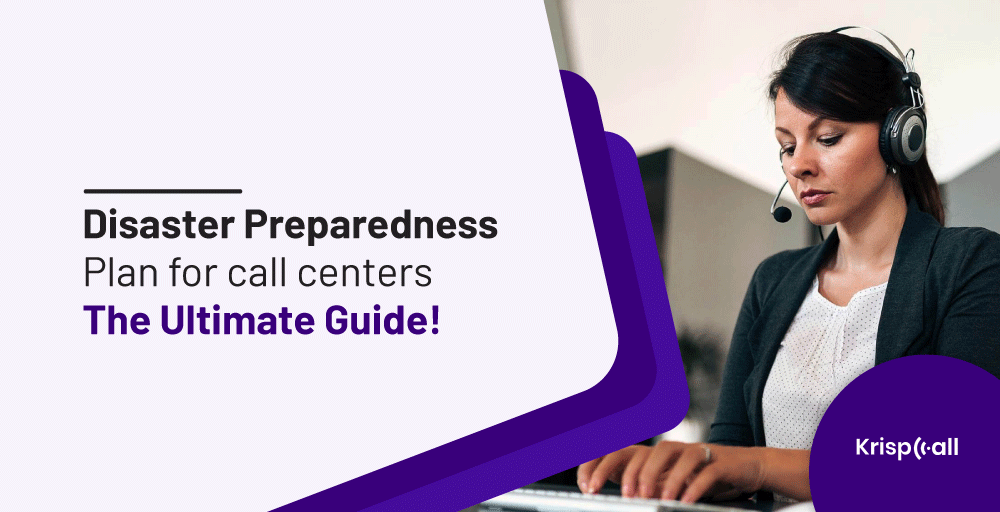Is your call center ready for an unexpected natural catastrophe that can sweep up your area 🌊? Or what if a fire 🔥 took out your main customer support office? Do you have any call center contingency plans?
A disaster can strike your business at any time, as we’ve seen during the years 2020 and 2021, and it is usually when you least expect it in any shape and form, but a disaster doesn’t always involve natural forces. It can affect everything from lives to businesses. So you need effective call center disaster recovery solutions for such occasions.
A huge disaster in a call center industry can cause massive power loss in businesses that include a high volume of messages, a shortage of communication due to internet failure, and financial losses added to secure customers’ loss of confidence in the product and the company.
A report in 2018 by the Federal Reserve Bank of San Francisco illustrates how US small businesses should handle unexpected disasters, and how to be prepared for facing them, and revealed shocking information that more than 300 billion dollars in expenditure damage small businesses.
Moreover, only 17% of them have contingency plans for disasters.
And, also illustrated that
Only 40-60% of businesses that go through a disaster will stay in business. However, those businesses have chances to fail after 12 months post-disaster.
With these, every call center is vulnerable to an outage. Having a disaster recovery plan in place is essential for proactively resolving an unexpected obtrusion, whether due to a natural disaster, severe power outage, or equipment failure.
This ultimate guide has integrated the challenges of implementing, managing, and disaster preparedness plans for call centers.
So, stick till the end!
But first, let’s know about different types of Disasters.
5 Different Types of Disasters for Call Center Business
Protecting and preparing for unexpected events, either it’s from interruptions or a “once in a lifetime” event to recurring seasonal call center service prevention, is vital in today’s highly competitive, 24/7 business environment.
Understanding the five types of disasters for call center businesses can help you with what you should prepare and what critical steps should be taken for business continuity after the hit of an emergency event.
Disaster Type 1: Health Pandemic
The health pandemic is most familiar to today’s human race. It has impacted people and business operations for two years in the world. Health pandemics made a new experience like social distancing measures, closed doors, and unpredictable occurrences.
Acknowledge the devastating effects of health outbreaks that could be faced by your business, including operations, workforce, contagious environment, and loss of efficiency that can result in improved time-off demands.
So, advanced planning and knowing your call center business can function to work are crucial.
Disaster Type 2: Natural Occurrences
Is your call center prepared for no “safe zone” from the fury of Mother Nature? Major natural occurrences can create dramatic and damaging weather patterns that can affect anyone from all parts of the country and the world.
Well, on-premise-based call centers can sense the consequences of storms and weather-related possibilities than cloud-based call centers scramble to immediately redirect calls to offshore resources
However, when existing sites shut down in cloud-based call centers, they also cannot redirect calls quickly or handle unexpected call volume risks, leading to losing customers.
Disaster Type 3: Man-Made Occurrences
Manufactured occurrences are the main cause of today’s call center flow down. These possibilities could comprise biohazard spills, bombs, terrorist threats, computer viruses, or security breaches.
When call centers flow down suddenly, clients who need assistance aren’t able to receive the services. This seems harmless at the start but can be expensive as your employees and transactions depend on the sheer volume of the missed calls can affect a company’s financial lowermost bar.
Disaster Type 4: Geopolitical Risks
Businesses that outsource to on-premise call centers should accept the risks caused by geopolitical possibilities. While these are the worst-case scenarios, political events must be considered when choosing a customer service provider.
Companies should do extensive risk assessments to identify the possibility of dangerous occurrences and analyze call center providers based on the country’s, region’s, government’s, and economy’s specific characteristics to make an informed decision.
Disaster Type 5: Company-Created Affairs
External influences aren’t always to blame for disasters. A lack of communication between internal departments can sometimes result in an unexpected increase in call volume.
Phone lines are inundated with calls about installation, resets, and functionality during the holiday season. While the corporation may sell more than expected, a lack of service planning leads to dissatisfied consumers and negative publicity.
Companies can also cause service issues when special-event advertising or promotional activities generate a flood of inbound phone calls, causing customers to be unable to reach them or be placed on hold for long periods.
Essential types of disaster recovery plans for call center business
As mentioned earlier, unexpected disasters can cause all sorts of damage to a call center. However, you can overcome these unexpected events with a proper call center disaster recovery plan.

The best practice with management consultants such as KrispCall can deliver the services you need from consultants and positively impact your ability to your call center business.
KrispCall makes you prepare for all types of disasters and construct a DR plan that accounts for all scenarios through which a call center suffers from a loss of technology, loss of staff, or loss of premises.
While there are many other disasters that you should be aware of, many of which are dependent on your geographic location, here is a list of disasters for which you should be prepared:
- Power outage for an extended time
- Failure of IT systems
- Snow
- Fires
- Strikes
- Thunderstorm/Hailstorm
- Floods
- Natural disasters such as earthquakes and other natural calamities
- Destruction, theft, and arson are examples of crimes.
- Civil unrest, such as riots
- Disruption of public transportation
It isn’t easy to know where to begin with such a diverse range of scenarios to consider.
A call center disaster recovery plan should be a comprehensive, recorded document that defines any form of disaster, the impact of that disaster (which could include loss of staff, loss of systems, or loss of structure), and recovery methods.
Disaster and Call Center Crisis Management
Despite being on-premise, the vast majority of cloud-based call centers are also unprepared to maintain company continuity in the event of an emergency.
Call center executives and senior management teams frequently must understand the impact that various catastrophes or emergencies can have on their operations, complexities as well as identify the best methods for dealing with the ones that are most likely to occur in their locations with the requirements of cost, resources, and technology.
However, a report says, “Most catastrophe planning in call centers focuses on recovery rather than continuity”.
For many years, call centers only had two recovery options to recover communications. For huge businesses, multiple call centers are diverted to the centers working effectively with several call centers.
The best alternative for smaller businesses, single-location contact centers, has a “hot site” where agents could go and calls diverted. In other situations, the hot site facility would have its agents on hand to provide coverage until the restored service.
Benefits of Having Disaster Preparedness Plan for Call Centers
Processes, people, and technology are important aspects of a well-thought-out business continuity strategy. Unfortunately, due to a lack of capability and flexibility, existing technology can severely limit the business continuity system plans in many contact centers.
However, knowing the different benefits of a disaster preparedness plan for call centers can help with these aspects.
Get a smoother Recovery
A proper business continuity plan can execute the recovery procedure easier and faster. This strategy will establish a secure relationship with your clients and let them rely on your organization even in a crisis.
It will also assist employees in understanding their part in the recovery process and eliminate the panic that often occurs in these situations.
Budget-friendly
A business recovery plan process can be incredibly cost-effective. These types of operations allow a company or customers to invest in crisis management over a longer period rather than only when funds are most needed to recover in an emergency.
Continue to rise and maintain
A business that relies on technology, internet sales, and customer service support will usually be wiped out by a catastrophe. A call center operation service can either diminish or increase a company’s scalability.
Get a Better Understanding of Your Customers
You will learn more about your consumers if you choose to deal with a call center during an emergency. Gathering critical data at these moments can help you predict what your clients require and may even lead to new ways for your company to provide them.
Create a sense of loyalty and trust among your customers
In today’s fast-paced world, a company’s future depends on its ability to provide great customer service. This desire does not halt because there is a problem.
Customers know they can trust you when you’re prepared for a crisis, and that trust will pay off in the form of long-term company loyalty.
Make you self-sufficient
Telephony services like KrispCall People can benefit organizations during a disaster. However, your company is likely to be placed on a waiting list for support in the vital care of human life.
While you wait for outside resources to catch up, a call center support service will allow you to get back to business.
Fewer Mistakes and Less Stress
Without a doubt, an emergency disaster situation will cause confusion and tension. It can draw attention to a company’s weaknesses.
When attempting to repay for these flaws, you might make mistakes in running your organization and responding to consumer requests. A disaster preparedness plan for your call center’s operation can reduce stress and stop errors.
Confidence for reuniting
We understand how difficult it is to keep good employees and keep them happy in the workplace. When your firm is prepared for a crisis, your employees will have more faith in it and perform better as a result.
You will maintain the top business strategy with a strong dedication to your firm if employees know that their organization has their back in an emergency.
Attention on the Right Place
In a crisis, your focus will be widely distributed. Keep track of all the variables, let alone your customers or providers.
While you manage the immediate infrastructure requirements, a call center provider may relieve that burden and provide exceptional customer service.
Removes the Burdens
Having access to a disaster call center’s broad network of resources is an added benefit of having one helping your company. Call centers have business networks to support many demands and scenarios, including many you may not even be aware of.
It could take the shape of certain outsourcing portions of your business or even hiring dispatchers to help a specific segment of your client.
These are instances that you can’t always plan for, but having an outside call center eliminates the need to look for these resources when you’re already overburdened.
What Should You Consider when Choosing a Disaster Recovery Solution?
When a call center is based on an on-premise environment, the only option for a call center is to attract from the positional cost of a duplicate premise-based system.
Even with this significant expense, there is no guarantee that agents will have access to the backup system in the case of an emergency.
The investment will grow even more if the call center wants to achieve geographic redundancy. Moreover, on-premise-based solutions also have flexibility and on-demand scalability; both features are required to ensure business continuity in many situations.
Conversely, Cloud-based solutions like KrispCall, are geographically independent, allowing agents, supervisors, and administrators to access them from any location with a phone and internet connection.
They’re excellent at disaster recovery, business continuity solutions, and redirecting your inbound numbers.
Furthermore, cloud-based call center solutions can be deployed as a primary solution, an additional backup to your existing premise-based or old cloud-based execution, and take its services at foremost either from calls, messaging or through email immediately.
The cloud-based call center provides some critical service outages using the same experienced agents and execution on various levels.
Here are a few things to think about when considering a call center disaster recovery solution:
Geographic Redundancy: This call center facility ensures that if one hosting site fails, all functionality is transferred to the other, which is involved in the features of geographic redundancy. Guaranteed redundancy uptime of 99.99 % is excellent.
However, it’s not enough if the system isn’t available when you need it.
Call routing flexibility: It ensures that you can stay connected at all times of your connectivity choices.
Depending on the situation, call routing rules can be changed quickly but even if some alternatives aren’t working, making calls to representatives ensures that you can make calls whenever you want during the circumstance.
Scalability: Check to see if your provider can handle large amounts of data. If you need to expand, you can do it right away, or makes you hold.
Network monitoring: Ensuring that the vendor is proactive in dealing with issues, Network monitoring should be available 24 hours a day, seven days a week, 365 days a year, and handles the problem promptly.
Ensure the seller: The call center provider should assist clients 24 hours a day, seven days a week, in the event of an emergency, and It doesn’t matter what time of day. A client must be the priority!
System Health Checks: Ensure your service provider can supply you with testing services for your call center system.
Conclusion
A disaster recovery/business continuity solution is available from various providers. Conversely, each provider takes a different strategy to disaster recovery.
Before choosing a supplier, call center executives must completely comprehend the potential dangers, capabilities, and financial implications and how they will be addressed.
Executives must be absolutely satisfied that their contact center is disaster-ready, and technology plays a major role in this preparation.
Conversely, Cloud-based solutions like KrispCall, are geographically independent, allowing agents, supervisors, and administrators to access them from any location with a phone and internet connection. They’re excellent at disaster recovery, business continuity solutions, and redirecting your inbound numbers.
Consult with Krispcall teams to know how it helps in disaster recovery for call centers.
👉 Get a KrispCall Free Demo Trial Today!
FAQ
What is a disaster management plan?
A disaster management plan is an outline plan mostly received from the Disaster management department under a particular municipal which will be helpful even to the business in case of disasters.
What are the steps for dealing with emergency conditions for all call centers?
The steps for dealing with emergency conditions for all call centers are:
-
Evaluate and determine which systems are in danger
-
Visit the secondary websites for contingency operations
-
Examine emergency and backup plans
-
Determine any risks
-
Carry out a power audit
What are the four different stages of disaster preparedness?
1) Mitigation
2) Preparedness
3) Response
4) Recovery
These preparation factors give a frame against unexpected events and help the economy and business recover faster.
What are the three elements of pre-disaster recovery planning?
– Setting goals
– Goals of the plan
Approaches for post-disaster recovery based on informed disaster scenarios.
What are the top five steps of emergency measures?
What is emergency preparedness?
It is vital for every business and people in natural and man-made circumstances.





